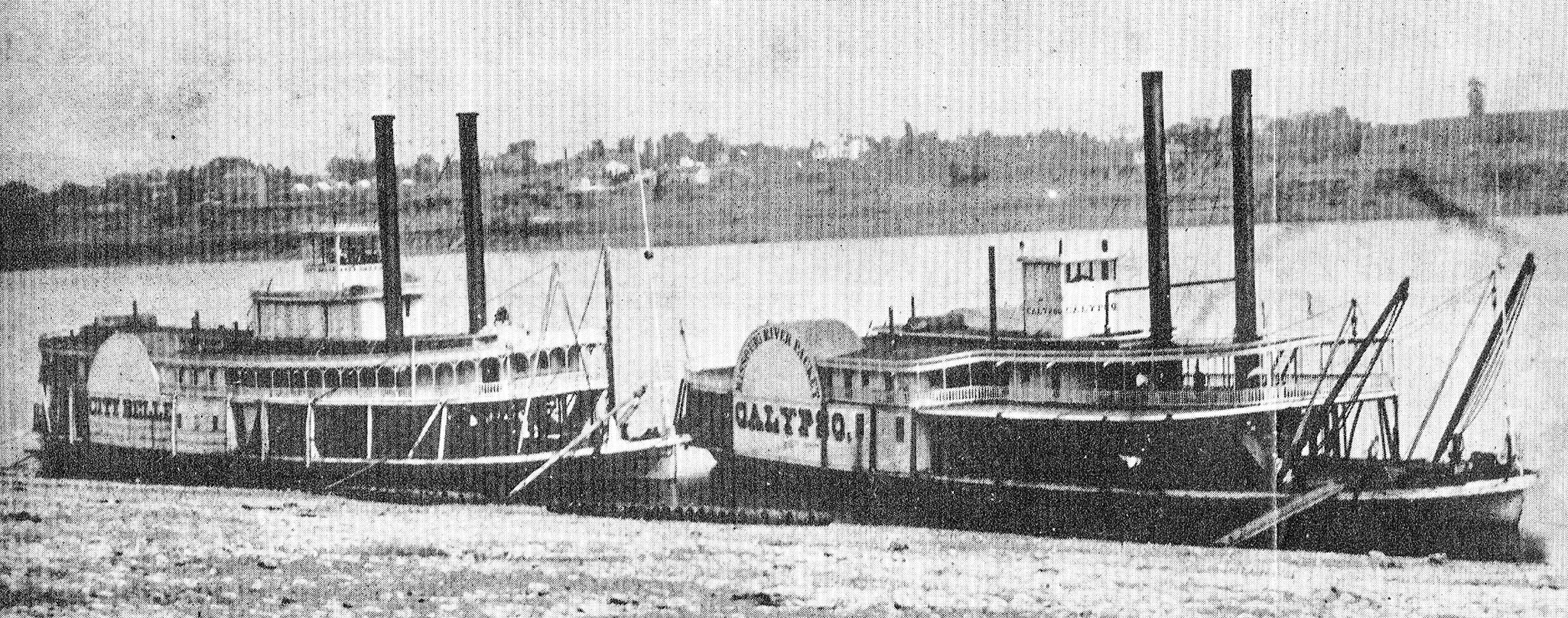This week, the Old Boat Column presents a picture of two rather obscure riverboats, the City Belle and the Calypso. Until 1961, the image was believed to have been taken at an Upper Mississippi River landing. However, later research and information obtained from a direct descendant of the photographer revealed the scene to be on the Missouri, near the town of Washington, Mo.
City Belle
Built in 1854 at Murraysville, Va., (now West Virginia), the wood-hulled packet measured 179 feet in length by 35 feet in width and was rated at 215 tons. The vessel’s first home port was Wheeling.
By 1855, the boat was operating for the Minnesota Packet Company, with Capt. Kennedy Lodwick as master. Capt. William Laughton was in command in 1856, with Capt. Lodwick returning to the post in 1857. Capt. A.T. Champlin served as substitute master for short periods. Records report that the steamboat cleared $30,000 profit during its first year of operation. From that time until 1858, the City Belle ran in the Galena–St. Paul trade. The boat subsequently ran in the St. Louis–La Crosse trade, with Capt. J.W. Campbell as master.
The United States Quartermaster Corps purchased the boat in 1861 and it was converted into a federal hospital vessel in 1863. The steamer arrived at Memphis on January 24, 1864, carrying 500 ill and wounded soldiers from Vicksburg. Shortly thereafter, the boat was assigned to U.S. Transport service under Admiral Porter on the Red River. On May 4, 1864, while en route to Alexandria, La., with an Ohio regiment aboard, the riverboat was captured and destroyed by Confederate forces, commanded by General Stafford, some 30 miles above Fort DeRussy, which was a Confederate stronghold during the Civil War.
Calypso
A bit larger than the City Belle, the Calypso had a wooden hull measuring 193 feet in length with a 30 foot beam. Built at Wellsville, Ohio in 1863, the boat carried two boilers which supplied steam to engines having 18-inch cylinders with a 5-foot stroke. Capt. A.S. Bryan served as master.
Although the steamboat was not engaged on the Lower Mississippi during the Civil War, it did witness some mild activity on the lower Missouri, where sentiment was strong for the Confederacy. In late 1864, the vessel was involved in the movement of Confederate prisoners from the federal prison on Gratiot Street in St. Louis to the Missouri State Penitentiary at Jefferson City. The prisoners, one of whom was Absalom Grimes (Confederate steamboat pilot, mail runner and a friend of Mark Twain) were taken by rail as far as Hermann, Mo., and then transferred to the Calypso, arriving at Jefferson City on November 13.
With a lifespan of only two years, the sidewheeler spent most of its career on the Missouri, although records indicate that the boat made several trips to the upper Mississippi as far as La Crosse. The Calypso was lost in an ice gorge at St. Louis on December 16, 1865, along with the Sioux City, New Admiral, Empire City, Hylander, Geneva, Metropolitan, four wharfboats and two barges.
Editor’s note: For questions or suggestions regarding the Old Boat Column, Keith Norrington may be contacted by e-mail at curatorkeith@yahoo.com, or by mail through the Howard Steamboat Museum at P.O. Box 606, Jeffersonville, Ind. 47131-0606.




